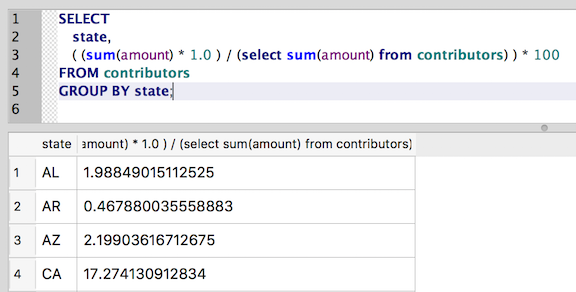Revisiting subqueries¶
Before wrapping up Part II, let’s revisit subqueries.
Recall that subqueries are SQL queries nested inside of a larger SQL statement.
They’re especially useful for dynamically filtering results on the fly as part of
the WHERE clause. As we saw earlier, subqueries let us base the results of
one query on the results of another, without having to run the queries separately.
But subqueries aren’t limited to use in the WHERE clause. Another
powerful – and perhaps surprising – use of subqueries is in SELECT.
For example, say that you wanted to determine the percentage of all contributions that came from each state.
You could perform this operation with two separate queries, starting with a sum of all contributions:
select sum(amount) from contributors;
The above query gives us a total of $106,865.
Next, we can use GROUP BY to sum contributions by state, and divide those totals by the sum of all contributions that we calculated above:
SELECT
state,
( (sum(amount) * 1.0 ) / 106865 ) * 100
FROM contributors
GROUP BY state;

This works, but wouldn’t it be nice if we could dynamically calculate the sum of all contributions, rather than hard-code the total from the first query? That way, our calculation should “just work” if we add more contributions to the database.
This is where the SELECT subquery can work its magic:
SELECT
state,
( (sum(amount) * 1.0 ) / (select sum(amount) from contributors) ) * 100
FROM contributors
GROUP BY state;

Above, we’ve simply replaced the hard-coded sum of all contributions with the query that generated the value. SQLite will calculate this total once and use it to determine each state’s percentage of overall contributions.
Not too shabby. Subqueries in select statements can clearly be a powerful tool
in your SQL skill set, especially when combined with aggregates, GROUP BY and
other SQL features we’ve covered in Part II.
A word of caution¶
With this new power, of course, comes responsibility. As you begin writing increasingly complex queries, they will become harder to read – not to mention debug.
Be cautious as you craft such queries, making sure to format the SQL in a readable way. Execute subsqueries independently before dropping them into a larger SQL query, to ensure they’re performing as expected. And for especially tricky syntax, add code comments to explain the logic.